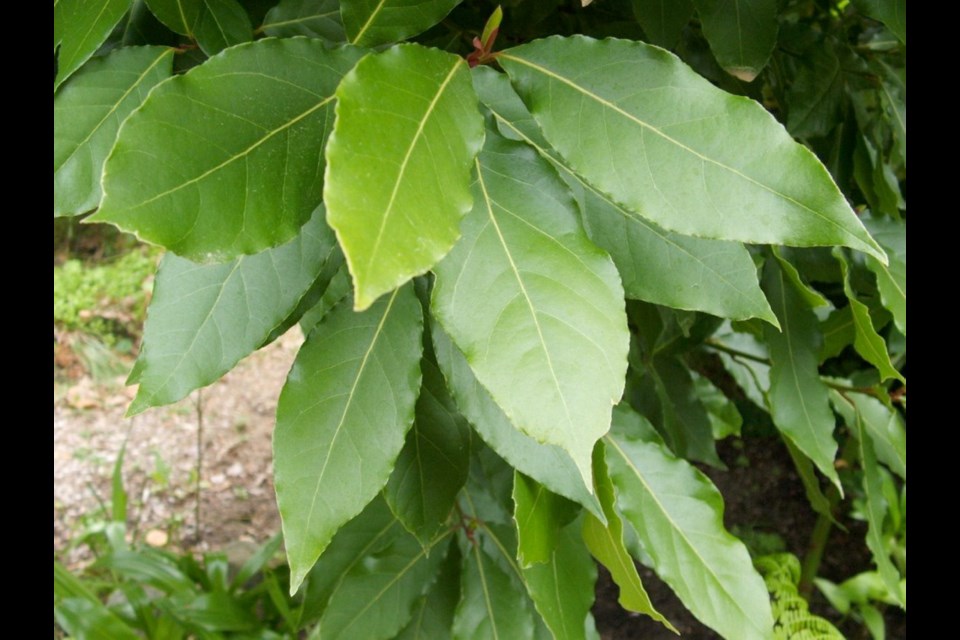I’m busy these days with secateurs, raffia, and sweet bay prunings, making simple swags for friends and neighbours. This weekend I’ll be pruning back some of the fir and cedar branches overhanging my side fences. The cedar and fir, and more sweet bay stems, will bring fresh seasonal greenery and fragrance into the house and add to the holiday atmosphere. I lay the greens on wide windowsills in the kitchen, dining room and living room.
I arrange them thickly also on a small metal trunk, one I bought in Kampala to bring my few belongings back with me to Canada. It is located outdoors, beside the front door.
Most gardens contain materials suitable for adding to a home’s holiday decor. Red dogwood stems and canes bearing rose hips are attractive. Viburnum tinus and Viburnum bodnantense ‘Dawn’ usually have flower or flowerbud clusters at this time in the year.
Look for broad-leaved evergreens with attractively variegated foliage, skimmia shrubs with red buds or berries, and traditional holly and ivy for brightening a home and adding to the festive atmosphere.
This year, I’ve been selecting the largest and most perfect leaves on the sweet bay stems for slipping into the Christmas cards I’ve been sending. The leaves are beautiful, useful, and fragrant, and my tree is large and in need of regular pruning. Sweet bay (Laurus nobilis, bay laurel) is the culinary bay leaf tree, not to be confused with ornamental laurels commonly used as broadleaf evergreen specimen plants and hedges.
Sweet bay leaves are popular for seasoning soups, stews, and cabbage dishes. They make nice book marks too, for those of us who still prefer to read from a paper book.
Book leaves. The best book marker leaves are ones that develop a scent as they dry, and retain the scent for a long while. Among all the leaves I’ve tried for the purpose, Bible leaf (Tanacetum balsamita, costmary) leaves are the best. The elongated ovals are just the right size and shape, and the perfume released as they dry is a delightful blend of sweet mint and eucalyptus.
When I used to accompany small groups of visitors through my garden, I always stopped at the costmary plants to pluck a leaf for each person in the group. The plants grow to around 90 cm tall, with soft grey-green foliage and clusters of tiny, bright yellow flowers.
The history of costmary goes back to Biblical times and its association with Mary, the mother of Jesus. In Victorian times the plant resided in every kitchen garden. Young leaves are used fresh in salads, soups and sauces. The leaves can be brewed into tea. Plants are available from Richters Herbs in Ontario.
Tangled steps. A short while ago, my neighbours Kim and Bob brought all the materials needed — black netting, poles, and ties — to increase the height of a short section of my front fence where a deer had jumped from the boulevard into the garden. The deer had roamed through the property, nibbling apple trees and grazing on carrot tops, radicchio and other autumn-winter greens.
With remarkable efficiency, Kim and Bob secured the poles and attached the black netting. With a few bits of flagging tape tied to the almost invisible netting, the project was completed in short order.
I noticed Bob checking for possible deer entry points into the garden from the sloping boulevard on the much longer section of front fencing on the other side of the driveway from the just-finished netting project. A deer has never jumped from the fairly steep slope, but it would be possible.
Bob mentioned that laying fish netting along vulnerable fence lines helps to keep deer from jumping because they will sense the danger of becoming ensnared in the netting.
Too bad. I was given fish netting years ago for possible use in the garden, but I gave it away in one of my paring down and clearing out sprees.
All is not lost though. I still have rolls of chicken wire, acquired long ago. It apparently has a similar deterrent effect. A 120-cm width of chicken wire, spread flat on the ground and staked down, helps to secure a garden’s perimeter. Deer apparently dislike walking on the wire. Chicken wire on the ground is a reasonable adjunct to fencing, because deer can jump so high.



